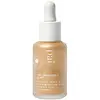What's inside
What's inside
 Key Ingredients
Key Ingredients

 Benefits
Benefits

 Concerns
Concerns

 Ingredients Side-by-side
Ingredients Side-by-side

Water
Skin ConditioningCitrus Limon Fruit Water
MaskingMica
Cosmetic ColorantGlycerin
HumectantAscophyllum Nodosum Extract
Skin ConditioningSclerotium Gum
Emulsion StabilisingHydrolyzed Glycosaminoglycans
HumectantSodium Levulinate
Skin ConditioningXanthan Gum
EmulsifyingSodium Dehydroacetate
PreservativeHyaluronic Acid
HumectantSodium Anisate
AntimicrobialLactic Acid
BufferingSodium Phytate
Maltodextrin
AbsorbentCI 77491
Cosmetic ColorantCI 77891
Cosmetic ColorantWater
Skin ConditioningCamellia Oleifera Seed Oil
Skin ConditioningRicinus Communis Seed Oil
MaskingPrunus Amygdalus Dulcis Oil
Skin ConditioningLactobacillus Ferment
Skin ConditioningCetearyl Alcohol
EmollientGlycerin
HumectantButyrospermum Parkii Butter
Skin ConditioningTocopherol
AntioxidantCetearyl Glucoside
EmulsifyingBeta-Sitosterol
Emulsion StabilisingRosa Damascena Flower Oil
MaskingSqualene
EmollientPelargonium Graveolens Oil
MaskingSodium Levulinate
Skin ConditioningLavandula Angustifolia Oil
MaskingLactic Acid
BufferingLitsea Cubeba Fruit Oil
MaskingSodium Stearoyl Glutamate
CleansingCitronellol
PerfumingLimonene
PerfumingGeraniol
PerfumingWater, Camellia Oleifera Seed Oil, Ricinus Communis Seed Oil, Prunus Amygdalus Dulcis Oil, Lactobacillus Ferment, Cetearyl Alcohol, Glycerin, Butyrospermum Parkii Butter, Tocopherol, Cetearyl Glucoside, Beta-Sitosterol, Rosa Damascena Flower Oil, Squalene, Pelargonium Graveolens Oil, Sodium Levulinate, Lavandula Angustifolia Oil, Lactic Acid, Litsea Cubeba Fruit Oil, Sodium Stearoyl Glutamate, Citronellol, Limonene, Geraniol
 Reviews
Reviews

Ingredients Explained
These ingredients are found in both products.
Ingredients higher up in an ingredient list are typically present in a larger amount.
Glycerin is already naturally found in your skin. It helps moisturize and protect your skin.
A study from 2016 found glycerin to be more effective as a humectant than AHAs and hyaluronic acid.
As a humectant, it helps the skin stay hydrated by pulling moisture to your skin. The low molecular weight of glycerin allows it to pull moisture into the deeper layers of your skin.
Hydrated skin improves your skin barrier; Your skin barrier helps protect against irritants and bacteria.
Glycerin has also been found to have antimicrobial and antiviral properties. Due to these properties, glycerin is often used in wound and burn treatments.
In cosmetics, glycerin is usually derived from plants such as soybean or palm. However, it can also be sourced from animals, such as tallow or animal fat.
This ingredient is organic, colorless, odorless, and non-toxic.
Glycerin is the name for this ingredient in American English. British English uses Glycerol/Glycerine.
Learn more about GlycerinLactic Acid is another well-loved alpha hydroxy acid (AHA). It is gentler than glycolic acid but still highly effective.
Its main role is to exfoliate the surface of the skin by loosening the “glue” that holds dead skin cells together. Shedding those old cells leads to smoother, softer, and more even-toned skin.
Because lactic acid molecules are larger than glycolic acid, they don’t penetrate as deeply. This means they’re less likely to sting or irritate, making it a great choice for beginners or those with sensitive skin.
Like glycolic acid, it can:
Lactic acid also acts as a humectant (like hyaluronic acid). It can draw water into the skin to improve hydration and also plays a role in the skin's natural moisturizing factor (NMF) in the form of sodium lactate.
Studies show it can boost ceramide production to strengthen the skin barrier and even help balance the skin’s microbiome.
To get results, choose products with a pH between 3-4.
Lower strengths (5-12%) focus on surface exfoliation; higher strengths (12% and up) can reach deeper in the dermis (deeper, supportive layer) to improve skin texture and firmness over time.
Though it was originally derived from milk, most modern lactic acid used in skincare is vegan. It is made through non-dairy fermentation to create a bio-identical and stable form suitable for all formulations.
When lactic acid shows up near the end of an ingredient list, it usually means the brand added just a tiny amount to adjust the product’s pH.
Legend has it that Cleopatra used to bathe in sour milk to help reduce wrinkles.
Lactic acid is truly a gentle multitasker: it exfoliates, hydrates, strengthens, and brightens. It's a great ingredient for giving your skin a smooth, glowing, and healthy look without the harshness of stronger acids.
Read more about some other popular AHA's here:
Learn more about Lactic AcidSodium levulinate is the a sodium salt of Levulinic Acid. If dissolved in an aqueous solution, the two ingredients become identical.
It is a skin conditioning agent, meaning it helps soften and hydrate your skin.
According to Cosmetic Ingredient Review, the highest amounts of sodium levulinate are found in mouthwashes at 0.62%.
Learn more about Sodium LevulinateWater. It's the most common cosmetic ingredient of all. You'll usually see it at the top of ingredient lists, meaning that it makes up the largest part of the product.
So why is it so popular? Water most often acts as a solvent - this means that it helps dissolve other ingredients into the formulation.
You'll also recognize water as that liquid we all need to stay alive. If you see this, drink a glass of water. Stay hydrated!
Learn more about Water